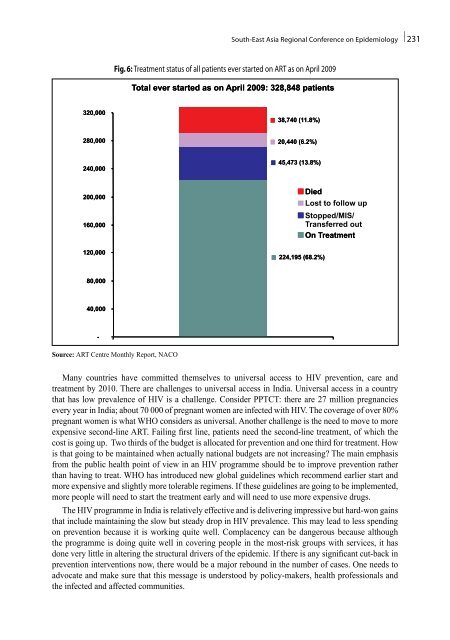South-East Asia Regional Conference on Epidemiology
South-East Asia Regional Conference on Epidemiology
South-East Asia Regional Conference on Epidemiology
You also want an ePaper? Increase the reach of your titles
YUMPU automatically turns print PDFs into web optimized ePapers that Google loves.
320,000<br />
280,000<br />
240,000<br />
200,000<br />
160,000<br />
120,000<br />
80,000<br />
40,000<br />
-<br />
<str<strong>on</strong>g>South</str<strong>on</strong>g>-<str<strong>on</strong>g>East</str<strong>on</strong>g> <str<strong>on</strong>g>Asia</str<strong>on</strong>g> <str<strong>on</strong>g>Regi<strong>on</strong>al</str<strong>on</strong>g> <str<strong>on</strong>g>C<strong>on</strong>ference</str<strong>on</strong>g> <strong>on</strong> <strong>Epidemiology</strong> | 231<br />
Fig. 6: Treatment status of all patients ever started <strong>on</strong> ART as <strong>on</strong> April 2009<br />
Source: ART Centre M<strong>on</strong>thly Report, NACO<br />
Total ever started as <strong>on</strong> April 2009: 328,848 patients<br />
38,740 (11.8%)<br />
20,440 (6.2%)<br />
45,473 (13.8%)<br />
Died<br />
224,195 (68.2%)<br />
1<br />
Lost to follow up<br />
Stopped/MIS/<br />
Transferred out<br />
On Treatment<br />
Many countries have committed themselves to universal access to HIV preventi<strong>on</strong>, care and<br />
treatment by 2010. There are challenges to universal access in India. Universal access in a country<br />
that has low prevalence of HIV is a challenge. C<strong>on</strong>sider PPTCT: there are 27 milli<strong>on</strong> pregnancies<br />
every year in India; about 70 000 of pregnant women are infected with HIV. The coverage of over 80%<br />
pregnant women is what WHO c<strong>on</strong>siders as universal. Another challenge is the need to move to more<br />
expensive sec<strong>on</strong>d-line ART. Failing first line, patients need the sec<strong>on</strong>d-line treatment, of which the<br />
cost is going up. Two thirds of the budget is allocated for preventi<strong>on</strong> and <strong>on</strong>e third for treatment. How<br />
is that going to be maintained when actually nati<strong>on</strong>al budgets are not increasing? The main emphasis<br />
from the public health point of view in an HIV programme should be to improve preventi<strong>on</strong> rather<br />
than having to treat. WHO has introduced new global guidelines which recommend earlier start and<br />
more expensive and slightly more tolerable regimens. If these guidelines are going to be implemented,<br />
more people will need to start the treatment early and will need to use more expensive drugs.<br />
The HIV programme in India is relatively effective and is delivering impressive but hard-w<strong>on</strong> gains<br />
that include maintaining the slow but steady drop in HIV prevalence. This may lead to less spending<br />
<strong>on</strong> preventi<strong>on</strong> because it is working quite well. Complacency can be dangerous because although<br />
the programme is doing quite well in covering people in the most-risk groups with services, it has<br />
d<strong>on</strong>e very little in altering the structural drivers of the epidemic. If there is any significant cut-back in<br />
preventi<strong>on</strong> interventi<strong>on</strong>s now, there would be a major rebound in the number of cases. One needs to<br />
advocate and make sure that this message is understood by policy-makers, health professi<strong>on</strong>als and<br />
the infected and affected communities.









